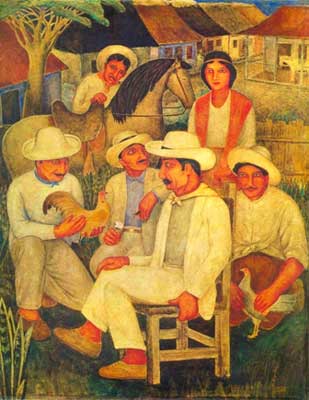Like Out of an Abela Painting
Janis Hernandez

HAVANA TIMES — Nature has been generous to our island. With its mountain ranges brimming with history, these are the genesis of our true folklore and the inspiration of our arts – especially painting.
Cuba has expansive areas described as countryside or rural areas, large tracts of land that until very recently were underutilized for agricultural cultivation and cattle breeding.
Campesinos — the men and women who live in rural areas and work the fields — have unique characteristics in their way of behaving, in their tones of speech and customs. “Campechanos” or “guajiros,” as they’re usually called, are known for being hospitable, caring and gentle.
They also tend to be great talkers, sharing their local legends and fables. To those people from any distance away, the people out here “crow like roosters.”
They’re always willing to share a sip of morning coffee, or heat up the coffeepot. The coffee here is made from pure beans picked from nearby plantations; it’s placed in drying decks and later roasted and then ground with wooden mortars in the shade of some tree.
Animals, streams, plains, mountains and modest people make up this this enticing world. Then too, there are its amazing shades of green and the area’s tunes or “controversy-style” singing, always accompanied by a swig of liquor and the arpeggio of an always close-at-hand guitar.
Feeding the population
These days, however, these good people with their sun and weather-beaten skin are carrying on their shoulders the weighty responsibility of providing the largest portion of food for the country. The farmers markets and state-run markets have changed. They began expanding their selections once “certain liberties” were given to farmers to market their own products.
Nonetheless, the prices remain too high for most folks whose wages barely allow them to buy more than a few vegetables. As for the farmers, they have to pay for their transportation and sell their produce to middlemen, who obviously raise the initial price since they too have to make a living and pay for their rental space, which the state provides to them at increasingly higher rates.
The meats, fruits and vegetables that make it onto our tables pass through a long series of transactions at ridiculous amounts. For example, the farmer will go to the state-run company to buy tools and supplies (hoes, machetes, fencing wire, gloves, fertilizers, harnesses, etc.).
Once the crops are harvested they have to rent transport vehicles (which almost none of them own their own). Then they have to pay taxes from out of their sales, though they can’t always fix their own prices themselves since these are established by government agencies.
When it comes to privately run businesses, the maximum sales prices are also fixed for them; therefore these entities are also prohibited from recouping substantial returns on their investments.
The fact is that it’s ultimately us — the consumers — who experience the consequences of so many controls and prohibitions.
Many people now use derogatory terms when describing campesinos, blaming them for all the shortages we’re forced to endure.
Bucolic farm life and the humble campesino have lost that charming image for those who have to worry about feeding their families in the towns and cities. The faces of those working and living in the Cuban countryside no longer seem like the quaint allegory of guajiros in the painting by Abela.*
—–
* Eduardo Abela, a Cuban painter and caricaturist. He was the creator of the created the comic strip character “El Bobo” (“The Fool,” as a protest against the Machado government) and the painter of the “Guajiros (a classic of Cuban work of art).





